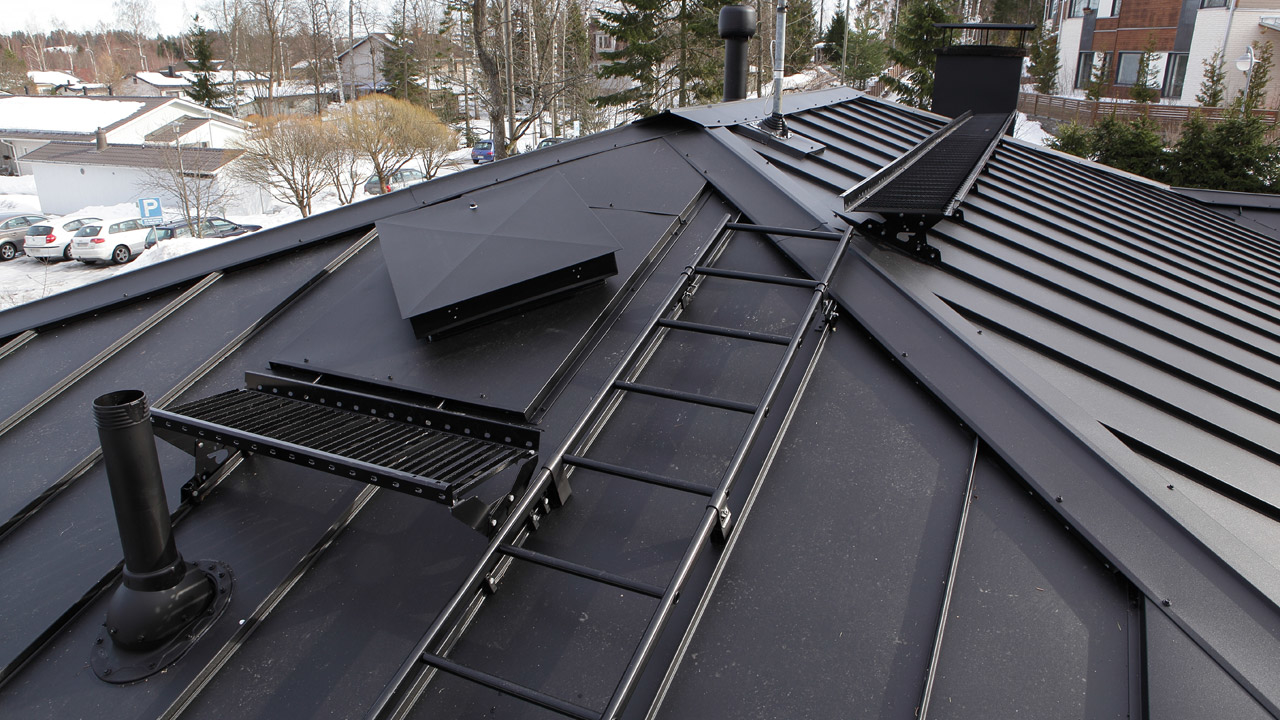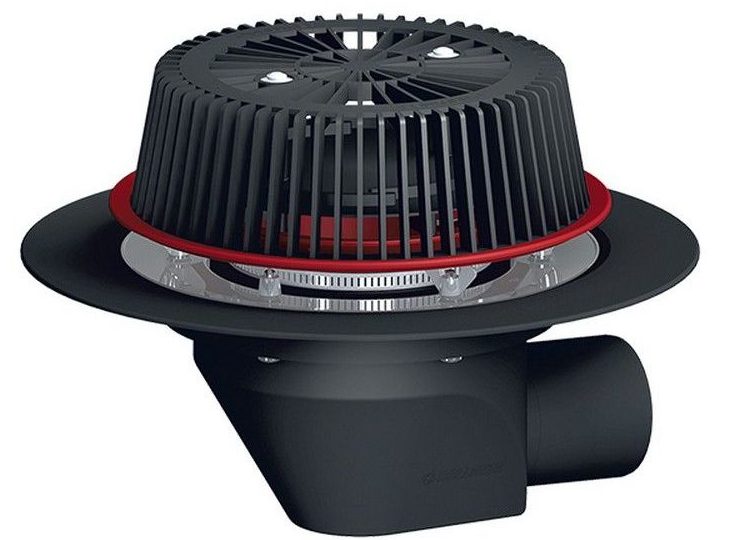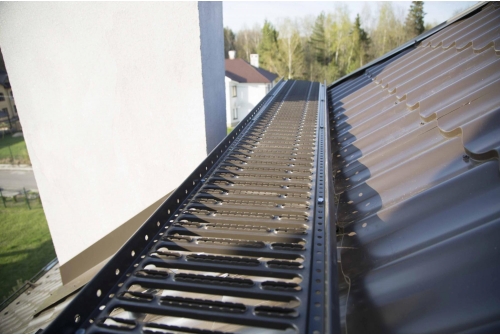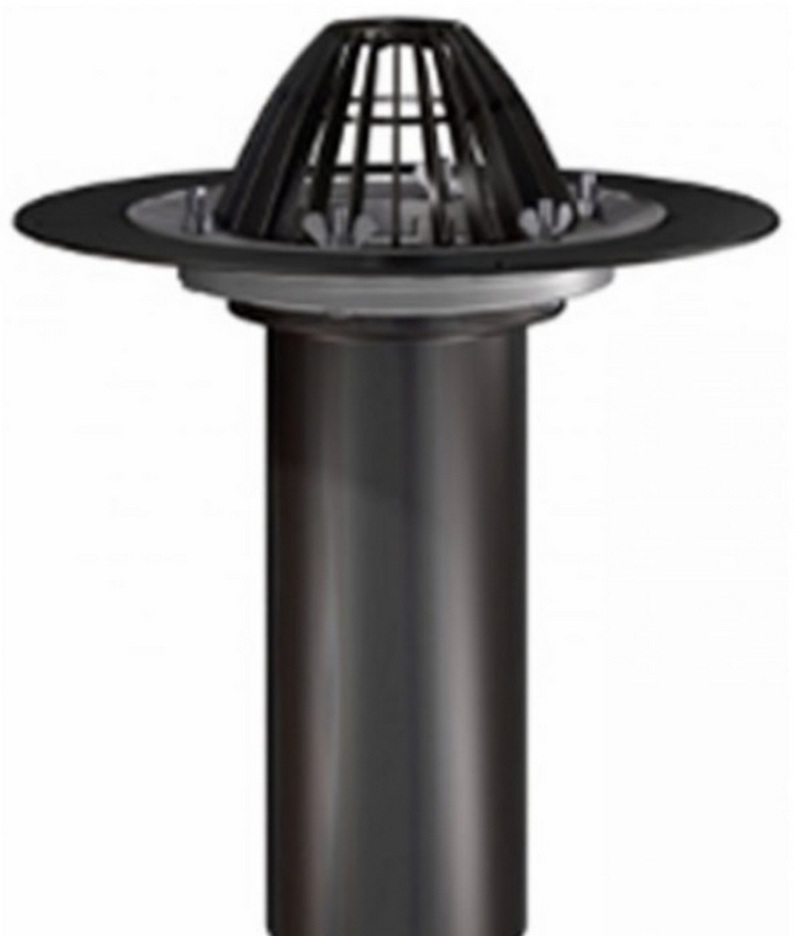Rating of the best roof drains and drains for 2022

Any roof should be equipped with special devices for its protection, as well as to facilitate its maintenance. For example, various weir systems, of which funnels are most often used, will significantly reduce the load from precipitation. They are installed along the slopes for gable roofs and around the perimeter - for four-slope. In order for the drainage complex to become as effective as possible, it is necessary to correctly select its design and material of manufacture.
In any case, whatever device is placed on the roof will require the presence of a person there for its maintenance. It should be convenient for him to carry out work on cleaning all roofing and over-roof structures from contamination, as well as to carry out unscheduled / scheduled roof repairs. In order to ensure safe and comfortable movement on the surface, it is required to install walkways on the roof, they are also ladders.

Content
Roof drains
Concept and principle of operation
The funnel on the roof is the main part of the drainage system. It is used to collect / divert sedimentary and melt water from the surface. Rain moisture through this device is first sent to the sewer, which can be located outside or inside the building, and then goes into the sewer, into the ground or special-purpose household containers. The products in question play an important role as building covering elements, because they are points of central moisture collection and require special conditions for their placement and installation. Accordingly, illiterate placement or improper installation will necessarily lead to premature repair of the roof.

Horizontal and vertical outlet
The classical design of the considered devices consists of three main elements. The extension part has a stainless grate and a drainage flange, which together form the upper lobe, the extension is the middle lobe, and the base, where the heating element is integrated, is the lower lobe. Depending on the scope of use, these products can be of the most diverse design. Horizontal and vertical variations differ from each other in the placement of the outlet pipe, i.e. liquid drain holes. In addition, models with swivel hinges can be used, in which the angle of rotation of the nozzle can vary from 0 to 90 degrees. If the funnel is placed vertically, then the pipes for it should go vertically.
At the moment, houses with roofs without attics have become widespread. In them, for water drainage, it is recommended to use systems with a horizontal outlet. At the same time, the product itself is fixed rigidly on the screed (under the waterproofing layer), and the outlet line is laid in the insulating layer, reaching some technical room, from where there is an exit to the sewer riser. In this case, most of the joints of the pipeline line will have to be laid through adapters. And in any case, the position of the conductive pipes will depend on the position of the funnel.
It should be clarified that the horizontal type of placement is considered less effective, because in the case of replacing any part, it will be necessary to open the roofing directly (and on a sufficient area). In addition, laying a horizontal line is associated with the need to take into account the level of freezing of home insulation.If the funnel outlet is placed above this level, then ice barriers can form in the pipe, which can persist until summer. These circumstances will clearly lead to stagnation of water in the pipeline and make it useless. Nevertheless, this problem has a solution in the form of the use of electrically heated devices. They are equipped with the device itself and they can be configured to turn on when a certain ambient temperature is reached. Naturally, such designs are far from cheap.
Modern types of funnels and their applicability to certain types of roofs
According to their purpose, the products in question are divided into:
- For membrane and bituminous roofs;
- For inverted and classic roofing materials;
- For working and unused roofs;
- For terraces and balconies.
Usually, in any architectural project, the drafters indicate the minimum drop points where it is desirable to install drainage systems. However, which funnel is suitable for a particular type of roof - this task is not for the architect, but for the designer of the water supply and sewage system.
Roofing funnel products must be selected based on the structural features of the surface, and the regulatory justification for the choice must comply with Building Regulations No. 20403 of 1985 and No. 20401 of 1985. To start work, the designer must have the following information about:
- Roof section with a detailed description of the layers and their dimensions;
- Material of manufacture and diameter of the storm pipeline;
- The need for an electric heating device;
- Special requirements for the funnel (information about excessive mechanical loads, about increasing the number of waterproofing levels, about placing directly above the living quarters).
IMPORTANT! In the most difficult cases, the designer will even have to contact the manufacturer, because. his staff can provide more accurate recommendations based on the roof section.
If the project establishes the impossibility of installing vertically oriented drainage systems, then it is possible to consider their horizontal options. For a better fit of the device itself to the vapor and waterproofing, and its base, in turn, to the roof surface, it is allowed to use models with an enlarged body. Also, it is possible to use products with adjustable hinges, which can be mounted to any riser with an angle of up to 90 degrees. However, all the "tricks" listed above are applicable only to residential buildings, and their use for industrial buildings (due to the specifics of the latter) is not allowed.
Installation and options questions
Funnels are an important roofing element, thanks to which precipitation can be successfully removed along the desired route. They will be able to function effectively even in the heaviest downpours, but this will require evenly placing the right number of devices over the entire surface of the roof. Places for installation must be selected on the basis of building codes and regulations regarding the installation of drains and sewers. The number of devices installed on a certain base will depend on the material of its manufacture, its own arrangement, operating conditions and the average amount of precipitation characteristic of the climate of the region of location.Traditionally, the products in question are installed one by one for every 200 - 300 square meters, and the distance between them should not exceed 25 meters. The type of model must match the type of roofing waterproofing used.
The funnel itself is fixed in the lower part of the roof, so that there are no problems with drainage. The slope towards the catchment must be at least 3% of the total angle. To prevent blockage of the main water collector, it is allowed to install two more (or more) similar products. However, with this design, a situation may arise when the entire highway cannot cope with the abundance of precipitation. In this case, the organization of an emergency system will be required.
Funnels can also be supplemented with optional elements:
- Crimp flange made of "stainless steel" for fixing to waterproofing with polymer-bitumen cloth for welding;
- Drainage nozzles and rings;
- Electrical heating equipment;
- Valves to isolate odor and prevent back draft;
- leaf catchers;
- Airless filters.
Separately, it is worth mentioning the repair funnel fixtures. They are designed to reduce labor costs when repairing roofs. They are characterized by the presence of a vertical outlet pipe, in which there is a large number of diametrically installed flexible skirts. If the storm drain is deformed or if the waterproofing needs to be replaced, the old fixture does not need to be completely dismantled. The repair device is installed inside the old one, and new insulation is simply brought under its flange. All these actions allow you to perform all repairs easily and quickly.
Roof ladders (crossing bridges)

General information and purpose
Structurally, these products are metal platforms that are equipped with special teeth and ribs. Such devices are attached to the floor (or to several ceilings) by means of brackets and provide proper adhesion. The part of the platform on which a person has to move has special holes (perforation) through which all natural precipitation (snow and water) is removed, from which the roof is not overloaded. Thus, the use of such devices is possible in any season.
Ladders are also designed to perform the following functions:
- Ensure safe movement of a person at a height and on surfaces with a large slope angle;
- Protect roofing material from deformation during repair / maintenance work;
- Maintain a complete system for movement by connecting individual ladders-bridges;
- Play the role of some kind of snow guard, protecting people passing below from avalanches.
It must be taken into account that the working platform can change the inclined angle due to the fact that the mounting bracket has holes of different levels. At the same time, the changed position can be fixed by means of bolts for fastening in certain holes (this option will become especially relevant for roofs with complex geometry).
Materials for the manufacture of ladder bridges
Most often they are made of aluminum and steel. In order to achieve special strength and a long period of operation, the steel in such products is galvanized. The coating can be either classic colorless or colored (the color is obtained as a result of interspersing polymer additives into the composition, which makes it possible to make a bridge to match the roof coating).Aluminum products are lighter in weight, which greatly simplifies their installation, while reducing the load on the coating. Moreover, the strength characteristics are slightly inferior to galvanized steel options.
Types of ladders
The type of these devices will depend on the installation method:
- Horizontal - fastening is carried out in parallel to the ridge and cornice, which is more often used in private buildings;
- Vertical - fixed on steep slopes when installed in a vertical position.
To increase the ease of movement, it is better to use a combination of two types.
Design features
The bridge ladder standard consists of the following elements:
- Platform - the basis for the movement of a person;
- Bracket - serves to fix the platform;
- Retainer - reinforces the bracket upon completion of installation;
- Planks - play the role of connecting elements;
- Fasteners - standard bolts, screws and nuts.
Additional elements include safety rails and handrails.
Classical bridges are characterized by a length of 1 - 3 meters with a width of 0.35 meters. The length of the structure can be increased by means of fixing latches. Fastening parts should be located in increments of a maximum of 1.2 meters, which will avoid deflection of the ladder, its breakage and deformation. Traditionally, three fixing points are installed - 2 lateral and 1 middle. If the size of the ladder starts from 3 meters, then four points will be needed for fastening. The tilt angle of the platform is allowed in the range from 3 to 45 degrees.
Mounting Features
Before starting the calculation of the number of required ladders, you need to decide which parts of the roof will require primary access (manholes, chimneys, ventilation pipes, drainage systems).Then the distance is measured from the nearest exit to the roof (from the balcony or from the hatch) to the required access point. The resulting distance is laid down in the length of the ladder. Only then are the desired brackets selected, whose type will directly depend on the coating. The installation process starts with marking the site and applying attachment points. As a base, strips are mounted on which clamps are fixed (they must be adjusted according to the angle of inclination). The last step is to secure the platform itself to the brackets.
The main advantages of ladders
Their installation on pitched surfaces is regulated by building codes and regulations, and they provide their users with a number of undoubted advantages:
- Movement becomes as safe as possible;
- The coating material retains its original qualities longer without violating the integrity and tightness, which will little depend on the scope, volume and time of the work being carried out;
- Installation does not create special labor intensity and financial costs;
- It is possible to build up the ladder system, modernize it, which will depend on the characteristics of the roof and expanding needs;
- It is possible to complete the ladders with optional protective equipment;
- Flexible adjustment of the platform inclination angle is possible with subsequent rigid fixation of the desired position through the fixing bolts;
- Increased throughput - snow and water easily pass through the ladders, which does not impede the movement of a person in any weather and in any season;
- Bridges can also play the role of snow guards, which guarantees the safety of people passing under the slopes from falling snow avalanches.
Rating of the best roof drains and drains for 2022
Roof drains
4th place: "125 x 340 NE-M Termoclip 319001"
This component is perfect for roof drains in the construction of flat roof surfaces. Made of durable steel, galvanized, which indicates a high level of protection against corrosive processes. It is installed vertically, additionally it has a grid that prevents fallen leaves from getting into the highway. The recommended cost for retail chains is 4200 rubles.

- Extremely reasonable price;
- Two levels of protection;
- Easy installation.
- Not detected.
3rd place: "TP-01.U.100 Tatpolimer 027-8611"
This model is intended for removal of rain and thawed water from flat roofs in the rain sewerage. Equipped with a leaf catcher and a stainless steel clamping flange to prevent twigs, leaves and other debris from entering the rainwater drain. Produced with an enlarged body for greater adhesion of the hydro- and vapor barrier to the funnel, and its base to the roof plane. It has technological holes at the base for additional fixation to the base roof - reinforced concrete floors, corrugated steel sheet, etc. The recommended price for retail chains is 5350 rubles.

- Case material – polypropylene;
- Clamping flange material - stainless steel;
- Throughput, not less than - 10 l / s;
- Operating temperature — from -50 °С to +90 °С;
- The maximum permitted load is 150 kg.
- Not detected.
2nd place: WB 110 x 160 Termoclip 301002 (with leaf catcher)
The product guarantees unhindered removal of moisture from the surface of the roofing mat, preventing water stagnation on the waterproofing coating. Recommended for use with modified bitumen based waterproofing materials. The funnel is made of low-density polyethylene, resistant to weathering and UV radiation. The recommended cost for retail chains is 5600 rubles.

- The presence of a foliage catcher;
- Wide temperature limits of operation;
- Sufficient height.
- Not detected.
1st place: "TP-01.U.100-E Tatpolimer 027-8610"
The model is equipped with electric heating, as well as a stainless steel leaf catcher and clamping flange, which helps prevent branches, leaves and other debris from entering the rainwater drain. Produced with an enlarged body for greater adhesion of the hydro- and vapor barrier to the funnel, and its base to the roof plane. It has technological holes at the base for additional fixation to the base of the roof - reinforced concrete floors, corrugated steel sheet, etc. The recommended price for retail chains is 6,500 rubles.

- The maximum permitted load is 150 kg;
- Voltage / maximum current consumption - 220÷230 V / 0.16 A;
- Heat dissipation of the cable, no more than 30 W/m;
- Connecting cable length, not less than 1.5 m (3x1.5 mm).
- Somewhat overpriced.
Roof ladders
4th place: "Russian Frontier L - 1.25 m for materials based on bitumen"
The ladder is a horizontal platform that is fixed on the roof and allows you to move along it in a horizontal direction, parallel to the ridge and the roof overhang. It is recommended to install the product taking into account the routes of movement for safe access to chimneys, ventilation outlets, antennas, external units of air conditioners for their maintenance and repair. It is powder coated with a special weather-resistant paint that does not fade, does not fade and provides a beautiful appearance for a long time. Capable of passing 60% of the snow, ensuring safe movement on the bridge in any weather. The recommended cost for retail chains is 4100 rubles.

- The metal thickness of the universal bracket is 1.5 mm;
- 8 stiffeners;
- Adjustment brackets ensure the horizontal position of the bridge at any angle of roof inclination (from 0° to 45°).
- Not detected
3rd place: "BORGE L - 1.5 m for metal tiles"
A fairly powerful model from a foreign manufacturer, which is focused on installation on a complex surface (tiles) with irregular geometry (mounting at an angle of up to 45 degrees is possible). The product is made of galvanized steel and provides for the presence of polymer inclusions to give the ladder different colors. The recommended cost for retail chains is 5400 rubles.

- The metal thickness of the universal bracket is 2 mm;
- There are 4 stiffening ribs that provide high side load and prevent twisting;
- Adjustment brackets ensure the horizontal position of the bridge at any angle of roof inclination (from 0° to 45°).
- Not detected.
2nd place: "BORGE L - 1.5 m for seam roofing"
This transitional bridge is made in the form of a horizontal platform, which is fixed on the roof and allows you to move along it in a horizontal direction, parallel to the ridge and roof overhang. The bridge is installed taking into account future travel routes for safe access to chimneys, ventilation outlets, antennas, external units of air conditioners for their maintenance and repair. The model is powder-coated with a special weather-resistant paint that does not fade, does not fade and provides the roof with a beautiful appearance for a long time. It has anti-slip teeth for better grip with shoes. The recommended cost for retail chains is 5950 rubles.

- Has anti-slip teeth.
- Presentable appearance;
- Anti-corrosion protection.
- Not detected.
1st place: "Russian Frontier L - 2.5 m for seam roofing"
A very expensive and wide model that can be installed at almost any angle. The ladder is able to provide access over long distances, while maintaining safety features for a person in any season. Easy to install and very easy to maintain. The recommended cost for retail chains is 9500 rubles.

- Convenient placement and possibility of modification;
- Installation at almost any angle;
- Easy care and snow retention.
- Somewhat overpriced.
Conclusion
Roof drains and drains are modern equipment for creating an optimal microclimate and the ability to move on roof surfaces. Their installation guarantees long and trouble-free operation of the coating. Products are attached to the finish coating or ceilings. For greater traction, special ribs and teeth are provided to ensure proper contact even in rain or snow.
new entries
Categories
Useful
Popular Articles
-

Top ranking of the best and cheapest scooters up to 50cc in 2022
Views: 131649 -

Rating of the best soundproofing materials for an apartment in 2022
Views: 127688 -

Rating of cheap analogues of expensive medicines for flu and colds for 2022
Views: 124517 -

The best men's sneakers in 2022
Views: 124031 -

The Best Complex Vitamins in 2022
Views: 121938 -

Top ranking of the best smartwatches 2022 - price-quality ratio
Views: 114978 -

The best paint for gray hair - top rating 2022
Views: 113393 -

Ranking of the best wood paints for interior work in 2022
Views: 110318 -

Rating of the best spinning reels in 2022
Views: 105327 -

Ranking of the best sex dolls for men for 2022
Views: 104363 -

Ranking of the best action cameras from China in 2022
Views: 102214 -

The most effective calcium preparations for adults and children in 2022
Views: 102010









